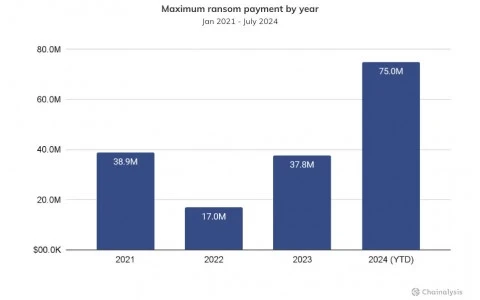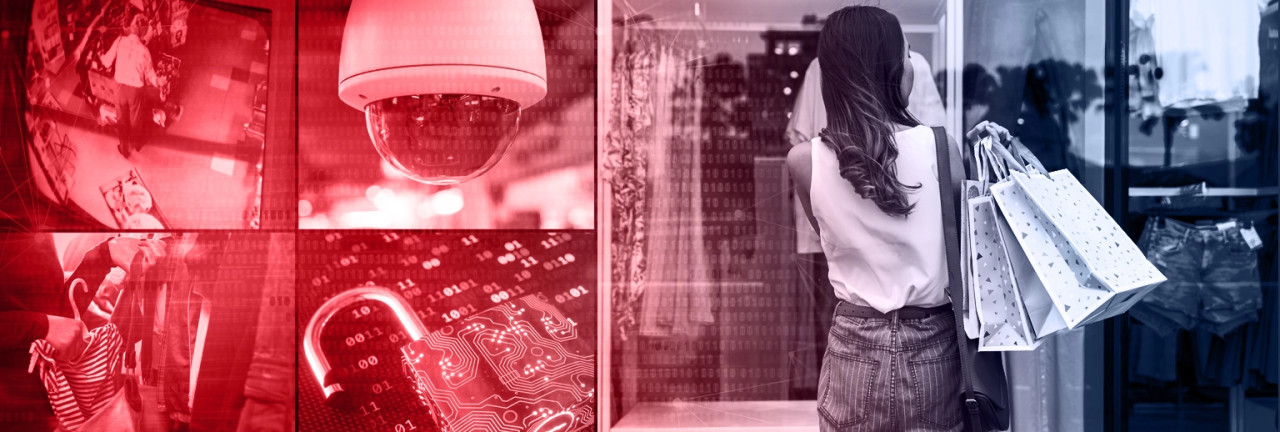Do you know Dmitry Yuryevich Khoroshev?
If you do, there's a chance that you might well on the way to receiving a reward of up to $10 million.
Law enforcement agencies across the US, UK, and Australia have named Dmitry Yuryevich Khoroshev as the mastermind behind the notorious LockBit ransomware group, estimated to have extorted $500 million from companies worldwide.
Although the rise in money criminals have generated through ransomware has risen by what may appear to be a small percentage amount (approximately 2% from US $449.1 million to US $459.8 million), this is in spite of disruption caused to ransomware-as-a-service operations such as LockBit and ALPHV/BlackCat by law enforcement agencies.
The figures for the first half of 2024 include the US $75 million reportedly paid to the Dark Angels ransomware gang by an undisclosed Fortune 50 company, in what was believed to be the largest ever single ransom payment made since records began.
The ballooning size of maximum ransom payments represents a 96% year-on-year growth from 2023, and a 335% increase from the maximum payment made in 2022.
Chainalysis's research reveals that the median ransom payment made in response to the most severe ransomware has rocketed from just under US $200,000 in early 2023 to US $1.5 million by mid-June 2024.
The researchers believe that this 7.9x increase in the typical size of ransom payment (a nearly 1200x rise since the start of 2021) suggests that larger businesses and critical infrastructure providers considered more likely to agree to make higher payments due to their greater access to funds and the more significant impact of downtime.
Against this backdrop, the study claims that ransomware victims are giving in to extortion demands less often. As it explains:
Posts to ransomware leak sites as a measure of ransomware incidents have increased YoY by 10%, something we would expect to see if more victims were being compromised. However, total ransomware payment events as measured on-chain have declined YoY by 27.29%. Reading these two trends in tandem suggests that while attacks might be up so far this year, payment rates are down YoY. This is a positive sign for the ecosystem signalling that perhaps victims are better prepared, negating the need to pay.
In short, ensuring that your organisation had prepared to respond to a ransomware attack is essential.
Many organisations underestimate the importance of having a robust incident response plan. But knowing how to respond, especially in those critical first 48 hours after a cyber attack, can be critical.
Do you worry your company won't know how to recover after a cyber attack? Has your business just been hit by ransomware and you're wondering what to do?
There's still hope.
Don't make the mistake of believing that your organisation will never be targeted. The right approach is to take proactive measures in advance - as it's not a case of whether your business will suffer the likes of a ransomware attack but when.
Make sure to read Exponential-e's step-by-step guide on ransomware remediation.
Stoli Group USA, the US subsidiary of vodka maker Stoli, has filed for bankruptcy – and a ransomware attack is at least partly to blame.
The American branch of Stoli, which imports and distributes Stoli brands in the United States, as well as the Kentucky Owl bourbon brand it purchased in 2017, was hit by a ransomware attack in August 2024.
The UK government has proposed extending its ban on ransomware payments to cover the entire public sector in an attempt to deter cybercriminal attacks and protect taxpayers.
A UK firm has been hit by a £3.07 million fine after being hit by a ransomware attack that exposed sensitive data related to almost 80,000 people, and disrupted NHS services.
For many Chief Information Security Officers (CISOs), the first challenge isn't stopping a breach, it's knowing where the breach could even happen. Healthcare IT estates are some of the most complex and fragmented in the public sector.
Across the Hospitality & Leisure sector, from pubs to five-star hotels - guests' expectations have evolved in ways that would have been impossible to imagine just a decade ago.
We've been hearing about the impending demise of the high street for years now, ever since online shopping and click-and-collect established themselves as part of our day-to-day lives. And yet, while brick-and-mortar retail has certainly been through a great many challenges and upheavals, it doesn't show any sign of going away quite yet. Rather than simply expecting customers to be content with previous generations' shopping experiences, the sector has demonstrated considerable ingenuity by taking full advantage of emerging technologies to deliver the kind of personalisation that would previously have been the sole preserve of online platforms.
The recently released NHS 10 Year Health Plan is part of the Government's mission to build a health service fit for the future. Setting out how the government will reinvent the NHS through three radical shifts: hospital to community, analogue to digital and sickness to prevention.
The retail playbook has been fundamentally rewritten. Customer journeys are omnichannel by default, IoT sensors are now omnipresent in both warehouses and shop floors, and AI is moving from pilot to P&L at an unprecedented pace. And the results are already proving transformative:
- Time-to-open: New stores and pop-ups are networked, secured, and POS-ready in days, not weeks.
- CX becomes predictive: Personalised offers and staffing respond to real-time signals, not yesterday's batch.
- Shrink is minimised: Vision-based loss prevention, plus better on-shelf availability.
- Cost-to-serve falls: Energy, logistics, and labour are optimised by rich streams of real-time date.
- Audits are boring (in a good way!): PCI and security postures are continuously and consistently maintained across estates and partners.
But in the race to access all these potential benefits, the winners aren't the ones with the flashiest demos – they're the ones with a rock-solid digital foundation that lets AI and IoT platforms scale safely, securely, and intelligently, store by store.
So, from Exponential-e's vantage point across cloud, connectivity, cyber, and communications, and our ongoing conversations with top retailers across the UK, here's what "AI/IoT-ready" actually means for the sector, and how we can begin laying those all-important foundations…
A network built for real-time, store-level intelligence
IoT and AI thrive on low latency and high availability, particularly when Point of Sale (PoS), inventory, and computer-vision workloads are increasingly interconnected. That means the underling WAN stops being a cost line and becomes a growth platform. Frictionless shopping experiences, incorporating queue-free checkout, real-time offers, and dynamic pricing, depend on fast, reliable data flows at the edge.
Software-defined networking, built on a private VPLS core, makes this practical at scale, offering centralised control, application-aware routing, seamless use of diverse access (i.e. ethernet, 4G/5G), and integrated security. Beyond the immediate operational advantages of avoiding hairpinning over the public internet and low, predictable latency, such networks offer the scalability and agility needed for pop-ups, seasonal peaks, and new store openings, where day-one uptime and policy consistency are required.
This should be complemented with enterprise IoT/M2M SIMs that deliver multi-carrier access and centralised control for store sensors, handhelds, lockers, smart signage, and similar devices.
Cloud and edge compute as a single, unified platform
AI-assisted retail is a hybrid sport: heavy training and data engineering in the Cloud, instant inference and control at the edge. To this end, retailers pursuing "always-on", augmented stores are converging 5G, IoT, and AI with edge compute to deliver truly personalised experiences in the moment, not hours later. This next-gen local processing, with edge computing implemented in every store, delivers a seamless PoS for customers, while simultaneously optimising staff's efficiency and reducing backhaul costs.
In the longer term, centralised data platforms and AI services can crunch multi-store telemetry for demand forecasting, replenishment, and customer analytics, offering a rich stream of actionable insights that enable reduced energy usage, automated restocking tasks, and smoother labour scheduling - immediate, powerful operational wins.
These capabilities can be developed into a standardised model and then be deployed, managed, and scaled consistently across new sites as retailers expand their operations. It's no surprise that multiple European retailers are already doing exactly this to not only protect their immediate margin and availability, but also accelerate their future growth plans.
Embracing the 'secure by design' model
Retail IT estates increasingly span POS, e-commerce, click-and-collect, and IoT devices. However, more devices and more data mean an increased attack surface, particularly when it comes to customers' payment data. As a result, robust security must be embedded in the design of all systems, platform, and processes, not bolted on later. Forward-thinking retailers are already rolling out this 'secure by design' approach, building customer trust through multi-layered, PCI-DSS-ready security ecosystems that allow for continuous monitoring and intelligently automated policy enforcement.
Secure Access Service Edge (SASE) has a key role to play here, converging network and security in the Cloud and offering numerous pathways to establishing identity-centric access, micro-segmentation of IoT devices, and uniform policies across stores and partners. Even with thousands of distributed end points, all this can be accessed through a single pane of glass - a "single source of truth" for all networks, devices, and workloads.
Taking the next step of your AI/IoT journey
AI and IoT in retail aren't separate projects; they must be treated as fundamental parts of a single, software-defined platform that reaches every shelf, sensor, and checkout. Build the network and edge right, wrap it with zero-trust security, and connect it to a governed data and AI backbone, then scale and optimise what works.
If you'd like this distilled into a tailored blueprint for your own estate (i.e. current stores, formats, and use-case priorities), we can map the stack, identify quick wins, and sequence the roadmap to outcomes, with everything overlaid by a single SLA, as a fully integrated service. Get in touch to discuss your own AI and IoT goals and let's make sure you're building on the right digital foundation!
A 30‑year‑old man has been charged with launching a cyberattack on the German subsidiary of Russia's state-owned oil giant Rosneft. The cyberattack, which happened in March 2022 in the aftermath of Russia's invasion of Ukraine, crippled the company's operations and cost millions of euros in damages.
Traditionally, retailers' biggest security concern has been theft, and so CCTV systems evolved to ensure shoplifters could be identified as quickly as possible and stock shrinkage minimised, forming a foundational element of on-site infrastructure. However, as retailers expanded their operations and looked to achieve seamless communication and interoperability between sites and warehouses, the security concern grew to include data theft, and so secure, resilient connectivity became a key priority.
What's happened?
Recorded Future has reports that the British Government is proposing sweeping change in its approach to ransomware attacks.
In a heightened cyber threat landscape - where ransomware attacks are increasing in frequency and sophistication - and having weathered the challenges of COVID-19 and the resulting move to hybrid working, the Finance sector is still continually challenged to demonstrate to its customers that critical services will remain available no matter what, and that sensitive financial data will remain fully secure at all times.
The UK's Legal sector must contend with some of the most stringent compliance and data protection obligations in the current digital landscape. For many years, this has hindered the progress of digital transformation initiatives within firms, but in recent years, in order to meet the challenges of COVID-19, many firms have seized the opportunity to modernise cumbersome legacy systems and develop cutting-edge IT infrastructure that enables their staff to work more flexibly.
In spite of the ongoing evolution of cyber security processes and technology, human error is still responsible for 95% of data breaches1. Phishing attacks alone represent a particularly insidious risk, with 91% of organisations experiencing a successful attack in 2021 alone2.




